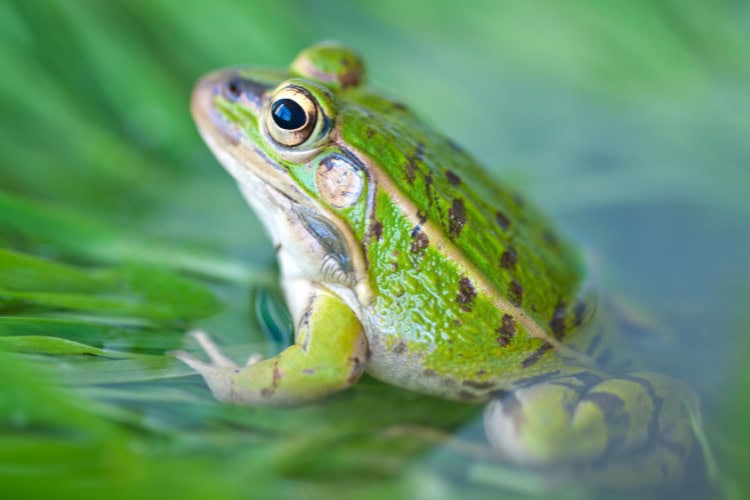Always wanted a pet but thought your apartment was too small, your schedule too hectic…or your allergies too fussy? Meet your new potential BFF: the frog!
Frogs are super interesting to watch, way easier to care for than a dog, and they’re even kinda cute (in that weird, blobby way). But, before you go adopting a tiny froggo, you gotta set them up with a sweet pad.
Let’s break down how to get a basic frog tank going without breaking the bank or your brain.
Table of Contents
- Importance of a Proper Habitat for Frog Health and Well-being
- Choosing the Right Tank: Your Frog’s Personal Palace
- Essential Components of a Frog Tank: Building Your Frog’s Paradise
- Climate Control: Keeping Your Frog Happy and Healthy
- Setting Up the Frog Tank: Your Transformation Guide
- Common Mistakes to Avoid: Saving Your Frog (and Yourself) Some Stress
- Final Words: Do Your Research and Ask for Help!
Importance of a Proper Habitat for Frog Health and Well-being
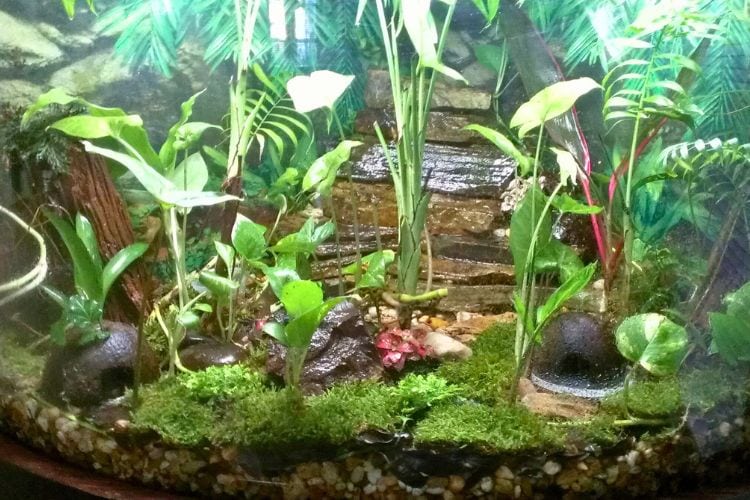
Think of your frog tank like a mini version of their natural environment. Getting their tank right is absolutely key for your new pal to do more than just survive – they gotta thrive! Here’s why a proper setup matters:
Happy Frog, Healthy Frog
A well-designed tank makes a world of difference to your frog’s health. It helps prevent:
- Skin problems: The wrong humidity or dirty substrate can lead to infections or weird skin shedding issues.
- Stress: If a frog can’t hide or feels too hot or cold, it gets stressed out, which weakens its immune system.
- Injuries: A tank that’s too small or has hazardous decorations can lead to accidental bumps and scrapes.
Chill Vibes
Frogs are super sensitive to their surroundings. Each species has a specific temperature and humidity range they need to be comfortable. A tank lets you control these factors, keeping your froggo feeling relaxed and safe.
Hidey-Holes
Imagine always feeling like you’re totally exposed with nowhere to run – stressful, right? Frogs feel the same! Hides offer both physical and mental security. A frog that can retreat to a dark, safe spot whenever it wants is way less likely to feel chronically stressed.
Room to Roam
While some frogs are pretty chill, others need space to hop around and explore! The right tank size lets your frog exercise those little legs and satisfy its natural curiosity, which is important for its overall well-being.
Cleanliness is Key
Frogs have sensitive skin that absorbs stuff from their environment. A dirty tank with old water and rotting food leftovers can make your froggo super ill, super fast! A proper setup makes it easier to maintain the right level of hygiene for a healthy frog.
Choosing the Right Tank: Your Frog’s Personal Palace
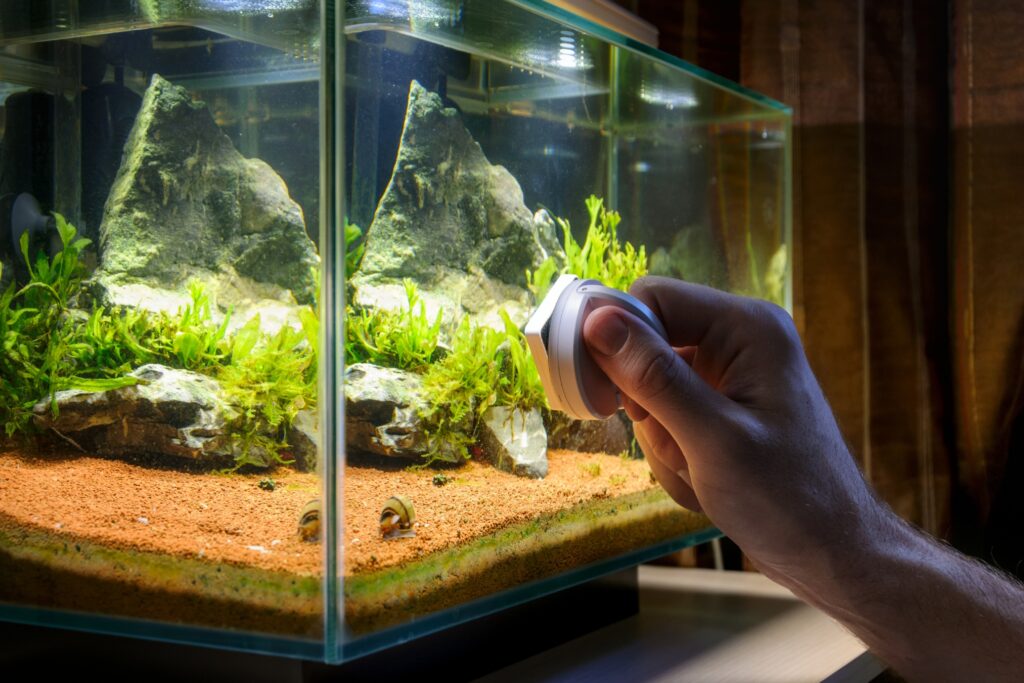
Finding the perfect tank for your froggy friend might seem overwhelming, but don’t worry – it’s actually quite simple! Here’s what to consider when selecting your amphibian abode:
Size Matters, But Not How You Think
You might be tempted to go big or go home, but for beginners, a smaller tank is actually better. Here’s why:
- Easier to Manage: A smaller tank means less space to clean and maintain, which is a big plus for busy folks or first-time frog owners.
- Security Matters: Frogs can feel overwhelmed in a giant enclosure. A smaller tank provides a sense of security and makes it easier for them to find food and hiding spots. Think of it as a cozy starter apartment for your frog!
Glass or Plastic? The Great Tank Debate
Traditionally, glass terrariums have been the go-to choice for frog enthusiasts. They offer excellent visibility and come in various sizes. However, plastic tanks have gained popularity in recent years, and for good reason:
- Lightweight Champions: Plastic tanks are significantly lighter than glass, making them easier to move and handle, especially for larger sizes.
- Shatter-Resistant Safety: Let’s face it, accidents happen. Plastic tanks are much less likely to shatter compared to glass, offering peace of mind and potentially saving you a trip to the emergency room (for both you and your frog!).
- Budget-Friendly: Generally, plastic tanks are more affordable than glass terrariums, which can be a major plus for cost-conscious beginners.
The Lid Situation: Keeping Your Escape Artist Contained
Frogs might seem like slow, docile creatures, but they can be surprisingly good jumpers, especially when startled! A secure lid on your tank is absolutely essential. Here are some options:
- Mesh Tops: Mesh lids provide ventilation while still keeping your frog safely inside. You can find pre-made tanks with mesh tops, or purchase mesh and modify an existing tank lid for a DIY project.
- Screen Doors: Repurpose an old screen door (with a frame!) as a lid for a larger tank. This allows for ventilation and offers easy access for cleaning and maintenance.
Finding Your Perfect Tank: Hitting the Stores (or the Web)
Now that you know what to look for, here are some tips for finding your ideal frog tank:
- Pet Stores: Most major pet stores carry a variety of terrariums and aquarium tanks suitable for frogkeeping. The benefit of shopping at a pet store is the ability to see the tanks in person and get advice from the staff.
- Online Retailers: The internet offers a vast selection of tanks at various price points. Before buying online, double-check the dimensions and ensure the tank includes a secure lid.
- Second-Hand Finds: Check online marketplaces or local classifieds for used tanks. This can be a budget-friendly option, but make sure the tank is in good condition with no cracks or leaks.
Remember, the most important factor is choosing a tank that’s the right size and has a secure lid for your chosen frog species. Don’t hesitate to ask questions or seek recommendations from experienced frog owners online or at your local pet store!
Essential Components of a Frog Tank: Building Your Frog’s Paradise
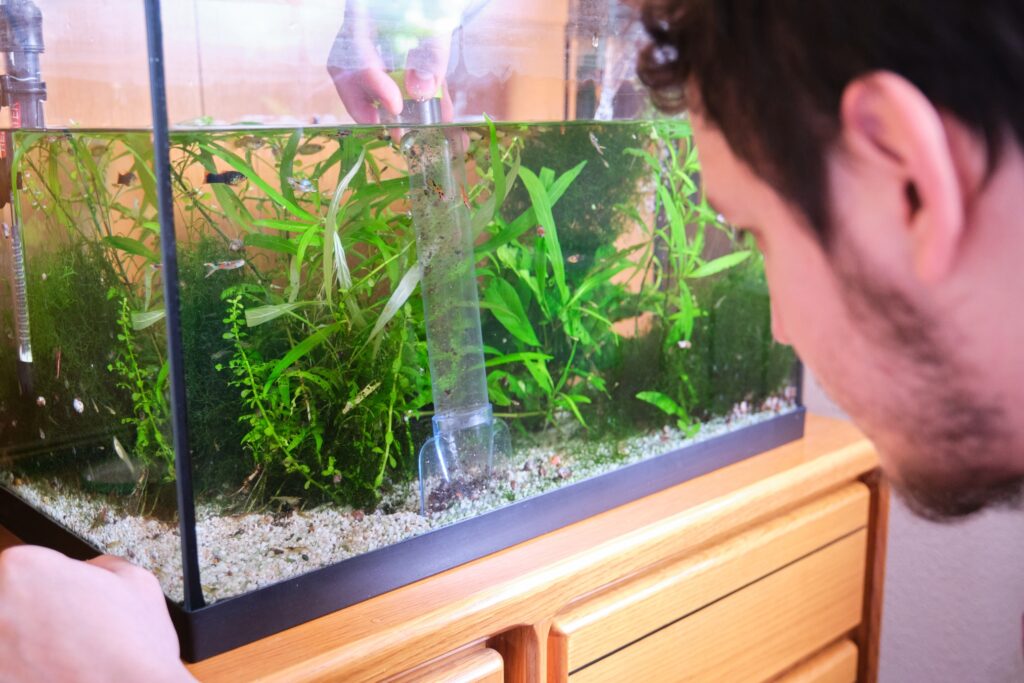
Think of your frog tank as furnishing a tiny apartment for your amphibious friend. Here’s a breakdown of the essentials they’ll need to feel at home:
Substrate: The Cozy Ground Cover
Substrate is the material that lines the bottom of your frog tank. It’s more than just for looks! Here’s why it matters:
- Digging and Burrowing: Many frogs love to dig or burrow a little. Choose a substrate that’s easy to excavate, like coconut fiber, soil, or moss.
- Moisture Management: The right substrate helps maintain the humidity levels your frog needs. Coconut fiber is a popular choice because it holds moisture well without becoming moldy.
- Safety First: Avoid substrates with sharp pieces or anything your frog might try to eat and get sick from.
Water Feature: Hydration and Hangout Spot
The type of water feature you need depends entirely on your frog species. Here are some common options:
- Simple Water Dish: For frogs that just need a place to soak and drink, a shallow dish of clean water is perfect. Choose a heavy dish they can’t easily tip over.
- Mini-Pool: Species that spend more time in the water will need a larger pool area within the tank. Make sure there’s an easy way for your froggo to get in and out of the water.
- Waterfall or Dripper Feature: While not strictly necessary, some frog owners like to add a waterfall or dripping water feature. This increases humidity and looks super cool!
Hides: Safe Havens for Your Shy Friend
Frogs need places where they can completely chill out and feel hidden from the world. Hides are essential for reducing stress since they help recreate a frog’s natural environment! You can get creative here:
- Store-Bought Hides: Pet stores sell tons of cute hide options – caves, hollow logs, etc.
- DIY Wonders: Half coconut shells, overturned flower pots, even pieces of PVC pipe can make excellent DIY hides (just make sure they’re not small enough to be a swallowing hazard).
- Naturalistic Vibe: Use rocks and driftwood to create natural-looking hiding spots that your frog will love.
Plants: Jungle Vibes and Climbing Fun
Plants add a touch of the wild to your frog tank and offer practical benefits too:
- Shade and Shelter: Plants provide extra cover, making your frog feel more secure.
- Climbing Adventures: Some frogs like to climb! Choose sturdy live or artificial plants for your little arboreal acrobat.
- Froggy Safeguard: Make absolutely sure the plants you choose are safe for your frog species. Some plants can be toxic if nibbled!
Important Note: Always clean and disinfect any natural items (rocks, wood, etc.) before adding them to the tank. You don’t want to accidentally introduce any parasites or diseases to your frog’s new home!
Climate Control: Keeping Your Frog Happy and Healthy

Imagine living in a house that’s constantly too hot or too cold, with the air feeling dry and scratchy. Not exactly ideal, right? Well, that’s what a frog tank with improper climate control can be like for your amphibian friend. Here’s why keeping the temperature and humidity just right matters:
Finding the Temperature Sweet Spot
Every frog species has a specific temperature range they thrive in. Some like it toasty, while others prefer things a bit cooler. Here’s the breakdown:
- Thermometer – Your Temperature BFF: A reliable thermometer is crucial for monitoring the temperature inside your tank. Place it in a spot where it won’t get directly heated by any lamps but still reflects the overall tank temperature.
- Heating Options: If your frog needs a warmer environment, you might need a heat lamp or an under-tank heater. Always follow the manufacturer’s instructions for safe installation and use to avoid overheating the tank.
- Too Hot, Too Cold – Not Good!: Temperatures outside the ideal range can stress your frog out, weaken their immune system, and even lead to health problems.
Humidity: Keeping the Air Just Right
Humidity refers to the amount of moisture in the air. Many frog species need a relatively humid environment to stay healthy. Here’s how to manage it:
- Moisture-Loving Frogs: Frogs that hail from tropical rainforests will need a higher humidity level compared to species from drier climates.
- Misting Magic: Regularly misting the tank with clean, chlorine-free water is a simple way to increase humidity.
- Live Plants FTW: Live plants in the tank naturally help maintain humidity by releasing water vapor into the air as they grow.
- Humidity Gauge – Your Moisture Monitor: A hygrometer or humidity gauge allows you to monitor the humidity level inside the tank. This helps you adjust your misting routine or explore other options if needed.
Maintaining the Balance: Avoiding Extremes
While keeping things warm and humid is important, it’s crucial to avoid creating a stagnant or overly damp environment. Here’s why:
- Ventilation is Key: Proper ventilation is essential to prevent stagnant air and mold growth. Most tanks have built-in ventilation gaps, but you might need to add extra mesh if needed.
- Too Much Moisture, Big Problems: Excessively high humidity can lead to respiratory infections in frogs. Monitoring the humidity level and adjusting misting or adding ventilation helps prevent this.
Remember, the specific temperature and humidity needs will vary depending on the frog species you choose. Researching your chosen frog’s ideal environment is key to keeping them happy and healthy in their new tank!
Setting Up the Frog Tank: Your Transformation Guide
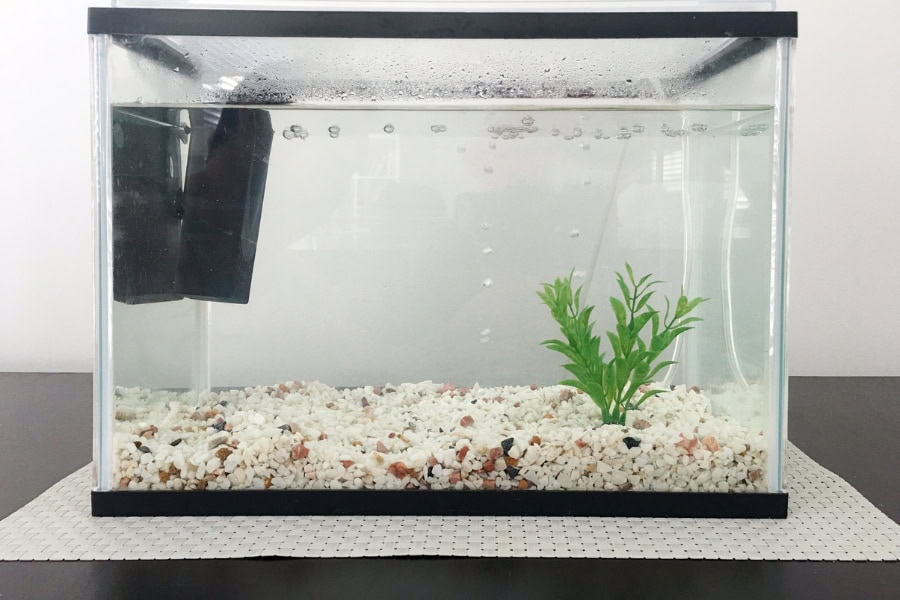
You’ve got your tank, your supplies, and you’re ready to create a happy frog haven! Let’s walk through the setup process step-by-step:
Location, Location, Location
Choosing the right spot for your tank is important for your frog’s well-being. Here’s what to keep in mind:
- Peace and Quiet: Frogs are easily startled by loud noises and vibrations. Pick a spot away from high-traffic areas, blaring TVs, or rambunctious pets.
- Light Control: Avoid placing the tank in direct sunlight, as this can overheat it quickly. Choose a spot with indirect light or where you can adjust lighting levels easily.
- Temperature Stability: Keep it away from drafts, radiators, or air conditioners, as these can cause rapid temperature changes, which we now know can wreak havoc on frogs.
Substrate Setup
Time to transform the bottom of your tank! Here’s the basic process:
- Rinse and Repeat: Thoroughly wash your chosen substrate material (coconut fiber, soil, etc.) to remove any dust or debris.
- Layer it Up: Spread an even layer of substrate a couple of inches deep throughout the tank. You can create slopes or interesting depths if you want, just ensure there are areas where your frog can easily reach the top layer.
Water Works
Let’s get those water features set up for your aquatic pal:
- Dishes vs. Pools: Set up a shallow water dish suitable for your frog’s size or create a larger pool area if your frog is more of a swimmer.
- Clean Water Only: Use dechlorinated or bottled water that’s safe for your frog. Tap water often contains chemicals that could make them sick.
Hide and Seek
Time to help your shy froggo feel safe and secure with some cozy spots to hang out:
- Variety is Key: Place a mix of hides throughout the tank. Offer some that are low to the ground and others with a bit of elevation, as your frog might have different preferences.
- Get Creative: Utilize store-bought hides, natural objects like coconut shells or rocks, and create climbing areas around plants for a sense of adventure for your frog.
Tech Check
Let’s get your climate control gear installed and working:
- Thermometer Troubleshoot: Securely attach your thermometer inside the tank where it won’t get knocked over or directly heated by a lamp.
- Adjusting the Heat: If using a heating lamp or under-tank heater, set them up as per the instructions and monitor the tank temperature closely for the first few days to ensure it remains within the ideal range for your frog.
Maintenance & Cleaning: Keeping Your Frog’s Home Sparkling
Think of tank maintenance as a little house cleaning for your froggo – not the most fun chore, but it’s super important for their well-being! Here’s a breakdown to make it as painless as possible:
Daily Spot Cleaning
These are quick, easy tasks that make a huge difference in keeping your frog healthy:
- Poop Patrol: Scoop out any frog poop you spot. This keeps the tank cleaner and reduces the risk of your froggo getting sick.
- Leftover Lunch: Remove any uneaten food before it has a chance to spoil and cause problems.
- Water Check: Ensure the water dish is clean and filled with fresh water.
Weekly Water Change
Even with spot cleaning, your water will need regular changes, here’s the deal:
- Water Swap: Change out the water in your frog’s dish or pool at least once a week. Always use dechlorinated or bottled water to protect your friend’s delicate skin.
- Quick Scrub: Give the water dish or pool a rinse with hot water and a clean sponge (no soap!). This gets rid of any slimy buildup.
Monthly Deep Clean
Think of this like spring cleaning for your frog tank! It’s a little more involved, but helps prevent bigger problems down the road. Here’s the process:
- Temporary Move: Gently move your frog into a temporary, secure container with a little of their old substrate to keep them comfy.
- The Full Scrub: Thoroughly clean the entire tank with hot water. Don’t use soap, as it can leave residue that’s harmful to frogs.
- Substrate Swap: Replace the old substrate with a completely fresh batch. This helps prevent buildup of waste that can be difficult to clean completely.
- Decor Detailing: Wash any hides or decorations with hot water and let them dry fully before putting them back in the tank.
Important Reminder: Always wash your hands thoroughly before and after handling your frog or working in their tank. It protects both you and your amphibious buddy!
Common Mistakes to Avoid: Saving Your Frog (and Yourself) Some Stress
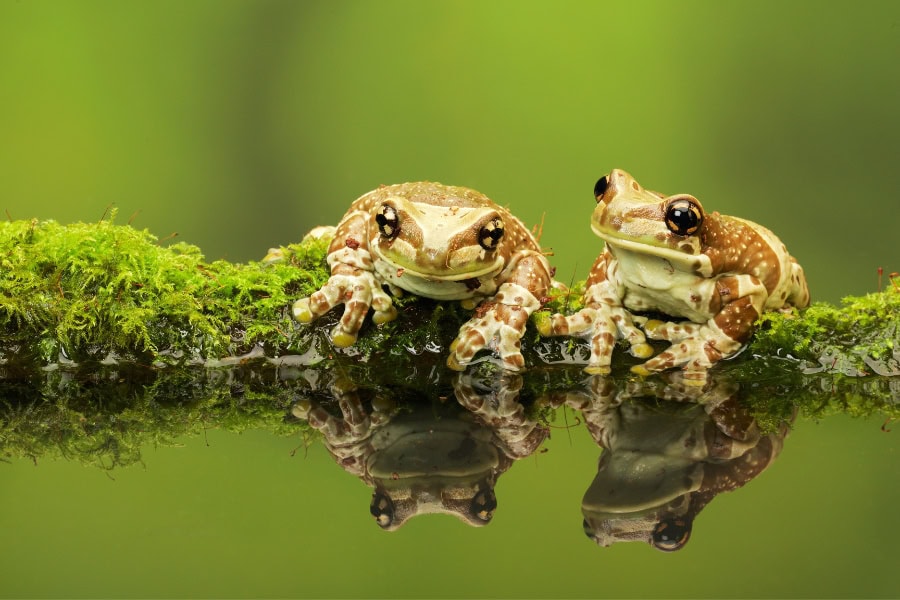
Even the most well-intentioned frog owners can make beginner mistakes. Here’s how to sidestep some common pitfalls for a smoother journey for both you and your froggo:
Overcrowding: Not a Froggy Party
It might be tempting to get a bunch of frogs to keep each other company, but resist the urge! Most frogs in the pet trade actually prefer living solo or in very specific group setups. Here’s why overcrowding is a bad idea:
- Resource Battles: Too many frogs in a small space can lead to fighting over food, water, or the best hiding spots.
- Stress City: Overcrowding increases stress levels, which weakens your frogs’ immune systems and makes them more prone to illness.
- Dirty Dilemma: More frogs mean more waste faster! This quickly overwhelms the tank, making it hard to keep clean and putting your frogs at risk.
Skipping the Lid: Your Frog’s Escape Plan
Frogs may look slow and lazy, but don’t let that fool you! They can be surprisingly strong jumpers with a knack for finding gaps to squeeze out of. Here’s why forgetting a secure lid is a major no-no:
- The Great Escape: An uncovered tank is an open invitation for your frog to hop out and vanish into your house. Sadly, most escaped frogs don’t survive long outside their tanks.
- Injury Risk: Even if you find your escaped frog, they might have gotten injured during their adventure, or been exposed to chemicals that could make them ill.
Forgetting the Research: Not All Frogs are Created Equal
It’s easy to fall in love with a cute frog at the pet store, but do your homework first! Different frog species have vastly different needs. Here’s the problem with jumping in without research:
- The Wrong Tank: A frog that needs a tall tank with climbing branches won’t thrive in a shallow, wide one. Your froggo could get stressed or even injured by an unsuitable setup.
- Incorrect Climate: Frogs from different places require different temperature and humidity levels. Getting this wrong compromises your frog’s health massively.
- Dietary Confusion: Different frogs eat different stuff! Some love crickets and worms, while others need specially formulated diets. Not providing the right food can lead to nutritional deficiencies.
Remember: A few minutes of research before you bring your frog home saves a lot of heartache (and potential vet bills) later on! There are awesome online resources specifically for frog owners where you can get reliable information on caring for your chosen species.
Final Words: Do Your Research and Ask for Help!
Setting up a simple frog tank is a lot easier than it might seem! Focus on the basics, do your research on the type of frog you want, and don’t be afraid to ask for help from other frog enthusiasts online.
Before you know it, you’ll be chilling with your new amphibious friend!

